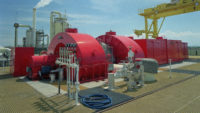Nashville International Airport has turned a former quarry on the site into the water source for a lake plate geothermal cooling system that is cutting energy consumption by more than 50%.
A 2012 sustainability study led to use of the big, water-filled hole as the cooling source for the $10.4-million geothermal system that cools the 900,000-sq-ft terminal building.
The energy savings are based on the first five months of operation and are projected to achieve annual savings of 1.3 million kilowatt-hours of electricity, 30 million gallons of potable water and utility costs of $430,000.
“I didn’t think we could have expected” that much reduction in energy consumption, says Christine Vitt, vice president for strategic planning and sustainability at the Metro Nashville Airport Authority. “We knew it would be significant … even 20% could be significant.
“The 50% improvement is specific to the kilowatt per ton of cooling produced by the chilled water plant,” she says. “Pre-implementation, it was taking more than 1 kilowatt per ton, versus just over 0.5 kilowatt per ton over the first few months of operation.
 “Our anticipated improvement of reducing energy consumption was initially from over 1 kilowatt per ton of cooling produced to 0.8 kilowatt per ton. We are seeing initial performance numbers as low as 0.5 kilowatt per ton of cooling, which is an improvement of more than 150% over anticipated.”
“Our anticipated improvement of reducing energy consumption was initially from over 1 kilowatt per ton of cooling produced to 0.8 kilowatt per ton. We are seeing initial performance numbers as low as 0.5 kilowatt per ton of cooling, which is an improvement of more than 150% over anticipated.”
The system can produce 3,600 tons of cooling at peak operation. It went on line in February and was completed in late May.
This lake plate system is said to be the only one if its kind in North America and possibly worldwide, engineers and energy consultants say.
“Nashville International Airport is fortunate enough to have a body of water on the property,” says John Waddle, project engineer with Energy Systems Group, Newburgh, Ind.
Other members of the design-build team include Garver, Little Rock; Smith Seckman Reid Inc., Nashville; and Blakley Construction Services LLC, Nashville.
The lake plate system involves 11 skids—each about 16 ft long, 12 ft wide and 5 ft tall and holding 26 plates—submerged about 50 ft deep in the quarry, where the temperature is a constant 50°F.
“Instead of a cooling tower, the water circulates to the plates, which are submerged in cold water in the quarry, and through heat transfer, the condenser water is cooled,” Waddle says.
Water leaves the terminal at about 79°F and comes back at 63°F. “We can return much, much cooler water [than a cooling tower] and bring that temperature essentially year-round,” he says.
Facilities such as airports, hospitals and prisons that operate around the clock “with a lot of internal heat, lights and people have a year-round cooling load,” he says. Their chillers are running on the coldest days.
The water constantly circulates through the cooling system, from a manifold to the quarry’s lake plates and back to the airport, in a 1.6-mile round trip.
The system—powered by three 125-hp pumps, one of which is a backup unit—can move up to 6,000 gallons per minute, depending on the season, Waddle says.
The system could be expanded with additional pumps to handle a $1.2-billion expansion and renovation project, announced on Aug. 1. The plan calls for expansions of two concourses, security lines, ticketing and baggage-claim areas and the main lobby and adding an on-site hotel.
That project, to take place over the next five to seven years, is planned to handle increased passenger traffic, which hit 12.3 million in the fiscal year ending June 30, up from the prior-year 11.2 million.
Airport officials are expected to name planning and design teams in the next year, a spokeswoman says.
The new system has to move the cooling water between the quarry and the terminal in a route that goes under Runway 2R/20L, its taxiway and a four-lane highway.
The runway crossing was a factor in the project timeline, as scheduled maintenance called for the runway to be closed for 60 days. Under that deadline, crews had to remove and replace a section of the pavement so the pipe could be laid, says Scott Terry, project director for Blakley.
That runway is only one of four at the airport, so traffic was diverted to the others during the maintenance period.
Though the project was announced in February 2015, it was June before all approvals were secured and contracts drawn up and signed. The design phase had to be completed in 60 days, so “it was a quick turn,” Terry says.
The team divided the project into three concurrent tasks: the quarry, the airfield and road crossings, and the condenser pumps.
“We had a good plan to get through the critical part of the work,” Terry says.
The water circulates through 20-in. HDPE pipe with 1.5-in. walls. Running alongside it for part of the run, a 4-in.-dia pipe moves water from the quarry to the terminal for landscape irrigation.
The top of the circulating pipe is at least 3 ft below the surface for geothermal insulation, “but the trench depth varied from 6 feet to 9 feet to provide the required 36-inch coverage and avoid utilities,” Terry says.
“Every piece of pipe trench was dug with a rock trencher,” he says. “At 2 feet down or 4 feet down, it was solid rock.”
The runway segment was finished in 45 days, says Ryan Sisemore, Garver vice president. The team tunneled under the highway, installing a 36-in.-dia casing pipe to enclose the 50-ft-long sections of water pipe, he says.
The HDPE pipe was chosen for its 50-year life expectancy, although it can last “closer to 100 years,” he says. Its fuse-welded joints “are as strong as or stronger than the pipe itself.”
While the pipe includes a recycled component and was manufactured by Elizabethtown, Ky.-based WL Plastics, keeping the source nearby and saving on hauling costs, the team isn’t seeking LEED certification. Instead, the team is aiming for the Institute for Sustainable Infrastructure’s Envision Award.
Waddle expects the system to last for more than 50 years. The pumps are the only moving parts, and the solid stainless-steel lake plates are underwater and not exposed to the atmosphere, he said.
The project was partially funded by the U.S. Federal Aviation Administration’s Airport Improvement Program. Other U.S. airports that have received FAA funds for geothermal systems are South Bend (Ind.) Regional Airport, Duluth (Minn.) International Airport, Portland (Maine) International Jetport and Knox County (Maine) Regional Airport. All those are completed.






Post a comment to this article
Report Abusive Comment